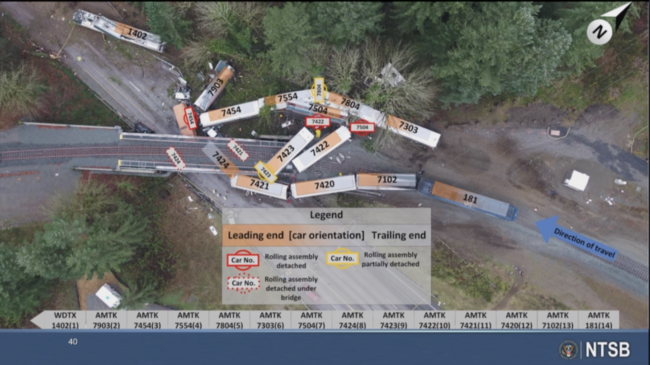7 Takeaways from the Point Defiance NTSB Hearing
 Schematic of the 2017 crash site (NTSB)
Schematic of the 2017 crash site (NTSB)
The National Transportation Safety Board held a hearing yesterday on the fatal December 2017 Amtrak derailment on the Point Defiance Bypass. The Seattle Times, Trains, and Curbed have reports. Here are a few takeaways, after watching the briefing:
Responsibility for safety was diffused, but the buck stops with Sound Transit. Amtrak, the Federal Railroad Administration, Sound Transit, WSDOT" with so many agencies involved, lines of accountability were unclear. Amtrak's role, in particular, is ambiguous - the company owns neither the tracks nor the trains, but as the nation's passenger rail operator it is supposed to oversee pre-revenue testing and certify the plans. In the end, the investigators made one thing clear: "Sound Transit had the ultimate responsibility to ensure that that project, the point defiance bypass, was safe and ready for revenue operations." Additionally, investigators called out ST, which owns the tracks as the "host railroad," for providing insufficient signage and schedules for the bypass.
There was a general lack of training. The crew lacked familiarity with the Siemens Charger and didn't know what to do when the "overspeed" warnings started going off (which was actually a separate issue from the failure to see the curve). Neither the conductor nor the engineer had enough time with this route and this locomotive.
Having been a friend of both Zach and Jim, I am saddened that the equipment they advocated for is being blamed rather than the culture that starts a new route, a new timetable and a new locomotive all about the same time.
- Erik (@erik_griswold) May 21, 2019
"Everyone hated that curve," the engineer told investigators. The curve was extra sharp connecting the bypass to the main line. The Wall Street Journal reported after the crash that the bypass project was value-engineered to save money, resulting in a sharper-than-ideal curve.
A road foreman even called Amtrak 501's engineer and told him 'remember that curve.' But no supervisor rode in the cab with the crew to make sure they didn't forget.
- Curtis Tate (@tatecurtis) May 21, 2019
Positive train control would have helped. Like many recent crashes, having positive train control would have stopped the train more quickly. Furthermore, in the absence of PTC, Sound Transit's risk mitigation plan was deemed insufficient. PTC has since been deployed.
The future of the Talgos is in the air. The trainset that crashed was a 1998 Talgo Series VI. The Series VI doesn't meet the FRA's 1999 safety requirements, which require the train to withstand much heavier collisions (though new FRA regs are different). Extra support cables, which were added to satisfy regulators, were starting to fail. The trainsets are 21 years old and may need to be replaced soon anyway.
No equipment is designed to fully withstand a collision at that speed. Even Rolling Tank-style American equipment crumples in a collision at speed; see other recent Amtrak crashes that have completely destroyed Amfleet cars. That's why *preventing* crashes is the right approach! https://t.co/KfOsCnZOeB
- Sandy Johnston (@sandypsj) May 21, 2019
The Series VI need to get a special waiver for each route they run on. Amtrak was given a waiver for the original Cascades route, and received a second one for use on the bypass just days before revenue service began. If they had to re-apply for that waiver today, it's not clear they they'd get it. The new Talgo Series VIII trains (purchased by Oregon DOT with stimulus funds in 2013) do not require the waiver.
Stimulus funds were not an issue. I was under the apparently mistaken belief that the bypass was pressed into service to hit a deadline set by the Obama administration for use of stimulus funds. The board and the investigators said that wasn't true. Instead, they said a decision was made in September of 2017 to have the route open by December and the pressure to hit the December date was internal to the agencies.
Many of the issues raised by the report have already been addressed by the various agencies. We'll have to wait and hear what WSDOT and Sound Transit have to say about plans going forward.